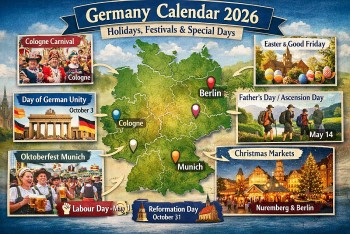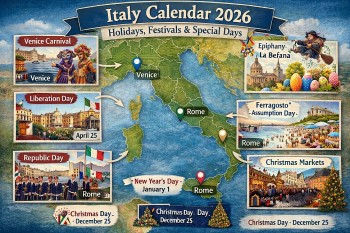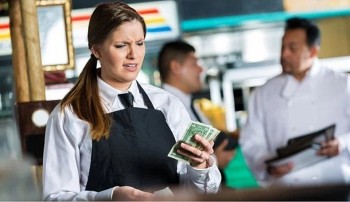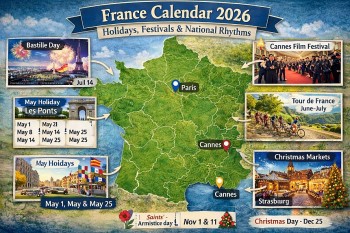How to Celebrate Persian New Year 'Nowruz': Traditions and Customs
 |
| Photo: KnowInsiders |
For millions of people across the globe, Nowruz is no small celebration. Think Christmas, New Year's and Fourth of July combined -- and add to it fire festivities, delicious meats, rice and spices, family gatherings, street dances and loud banging on pots.
But it's much more than that, too. Nowruz "promotes values of peace and solidarity between generations and within families," the United Nations says. It's a time of reconciliation and neighborliness, "contributing to cultural diversity and friendship among peoples and different communities."
What is Nowruz?
The word Nowruz (Novruz, Navruz, Nooruz, Nevruz, Nauryz), means new day; its spelling and pronunciation may vary by country.
Nowruz marks the first day of spring and is celebrated on the day of the astronomical vernal equinox, which usually occurs on 21 March. It is celebrated as the beginning of the new year by more than 300 million people all around the world and has been celebrated for over 3,000 years in the Balkans, the Black Sea Basin, the Caucasus, Central Asia, the Middle East and other regions.
| Nowruz 2022 will be at 22:32 on Sunday, March 20 |
Inscribed in 2009 on the Representative List of the Intangible Cultural Heritage of Humanity as a cultural tradition observed by numerous peoples, Nowruz is an ancestral festivity marking the first day of spring and the renewal of nature. It promotes values of peace and solidarity between generations and within families as well as reconciliation and neighborliness, thus contributing to cultural diversity and friendship among peoples and different communities.
Nowruz plays a significant role in strengthening the ties among peoples based on mutual respect and the ideals of peace and good neighborliness. Its traditions and rituals reflect the cultural and ancient customs of the civilizations of the East and West, which influenced those civilizations through the interchange of human values.
Celebrating Nowruz means the affirmation of life in harmony with nature, awareness of the inseparable link between constructive labor and natural cycles of renewal and a solicitous and respectful attitude towards natural sources of life.
Who celebrates it?
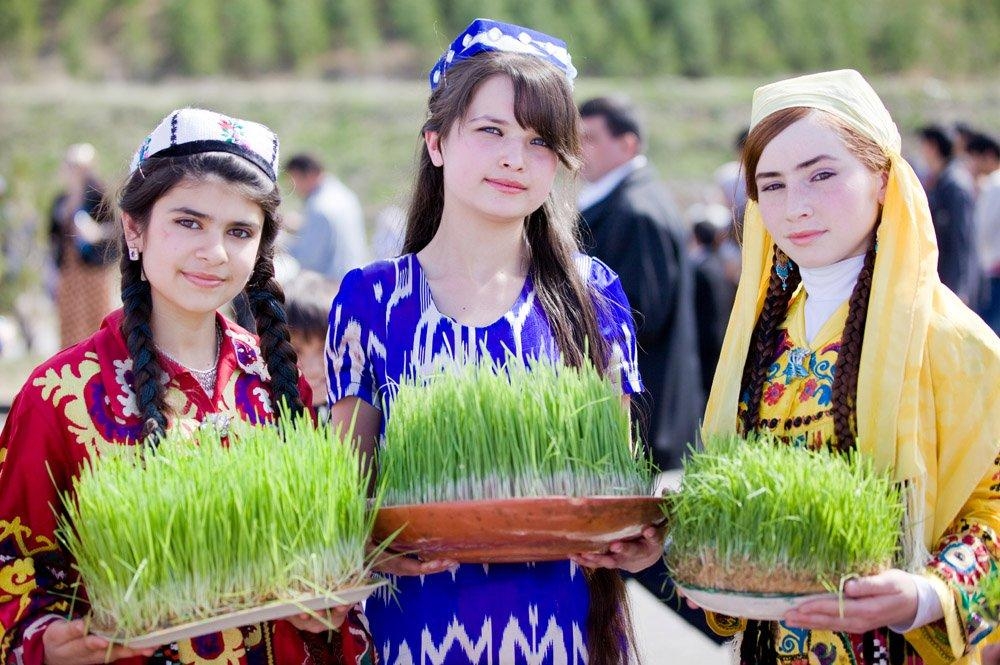 |
| Photo: Living in Tehran (LiT) |
March 21 was officially recognized in 2010 as International Nowruz Day by the United Nations at the request of countries including Afghanistan, Albania, India, Iran, Kazakhstan, Turkey and Turkmenistan.
Kyrgyz youth take part in the traditional game 'Kyz Kumay' ('Kiss a girl') during Nowruz celebrations in Kyrgyzstan's capital Bishkek on March 21, 2013.
But its reach is even wider. More than 300 million people worldwide celebrate Nowruz -- and have celebrated it for more than 3,000 years -- from the Balkans to the Black Sea Basin to Central Asia to the Middle East and elsewhere.
Hundreds of US communities celebrate Nowruz, too.
Los Angeles, home to one of the largest Persian populations outside Iran, prides itself on hosting the largest Nowruz festival in the country, with daylong festivities for visitors of any age. You can also find a Nowruz celebration in almost every state in the nation. Though, due to the coronavirus pandemic, festivities will be understandably muted this year.
The story of Nowruz
The celebration of Nowruz dates back to at least the 11th century A.D. In the Shahnameh – or “Book of Kings” – a text that dates to the first century, the story of King Jamshid is told as part of the Nowruz origin story.
King Jamshid, the fourth king in an imagined dynasty, is introduced as the kindest and most knowledgeable ruler of Persia, the region that stretched from what is modern Turkey to Pakistan. Jamshid is referred to in Zoroastrian texts from the first century as well.
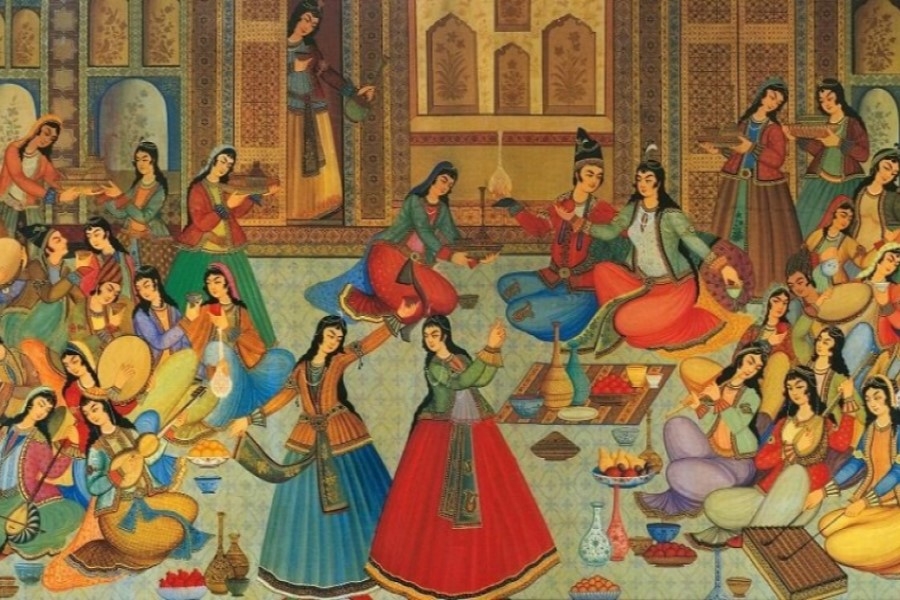 |
| Photo: Exotigo |
The Shahnameh tells the story of a king who was very sensitive not only to his subjects but also to the rhythms of the Earth. King Jamshid noticed that during the long, dark winter months, his subjects descended into darkness as the Earth worked to heal itself from the harvests of the fall.
When spring finally came and the Earth began to blossom after the healing period of winter, the king wanted to mark that as the start of the new year – a time of new beginnings for people and the Earth.
But King Jamshid also noticed that during those dark winter months, many of his subjects had started to quarrel with one another, and injustice threatened to take over. The king decided to mark the beginning of Nowruz with a festival called Shab-e-Charshanbeh Souri, which translates as “Scarlet Wednesday.”
The festival involves jumping over a series of fires – a tradition brought by the Zoroastrians, who worshiped fire as the sign of everlasting strength and health. The idea behind Charshanbeh-Souri is to jump over the fires to cleanse oneself of the ills – physical, emotional and societal – of the past year. It is a way to prepare for the rebirth that Nowruz brings.
How is Nowruz celebrated?
Before the holiday, people prepare for Nowruz with a 19-day Bahá’í fast. They go without food from sunrise to sunset.
During this time, people also focus on daily prayers and reflections.
Some get ready for Nowruz by cleaning their house from top to bottom and decorating their homes with fresh flowers.
When Nowruz finally arrives, people dress up and visit with friends and family, celebrating with prayers, music, dancing and feasts.
| 5 Nifty Facts About Persian New Year 1. Persian New Year always begins on the first day of spring – the Vernal Equinox – which is symbolic of new life, rebirth, new beginnings, and renewal. The celebration has its roots in Zoroastrianism, and has been observed by the Iranian people (once known as the Persians) for at least 3,000 years. 2. An important tradition is the Haft Sin or Seven S’s, items on a table that symbols spiritual virtues. Customarily, the Haft Sin consists of apples for beauty (Sib), dried lotus tree fruit for love (Senjed), vinegar for patience (Serkeh), sumac berries for sunrise (Somaq), garlic for health (Sir), sweet wheat germ porridge for affluence (Samanu), and a dish of sprouted wheat barley for rebirth (Sabzeh). Additional items that may be included are coins (prosperity and wealth), decorated eggs (fertility), goldfish (life), and hyacinths and tulips (spring). 3. The colors of Persian New Year are red, white, and green – the colors of the flag of Iran. 4. Hajji Firuz is a singing, dancing figure playing the trumpet and tambourine who heralds Persian New Year. His face is painted black and he wears red. His visit to a family’s home is supposed to bring happiness, blessings, and abundance in the coming year. Hajji Firuz is also the assistant of Amoo Norooz, who, like Santa Claus, brings gifts to children. 5. A divination ritual practiced by some during Persian New Year is to hide somewhere and eavesdrop on other people’s conversations. Hearing good news or a positive conversation means good fortune. |
What are Nowruz traditions?
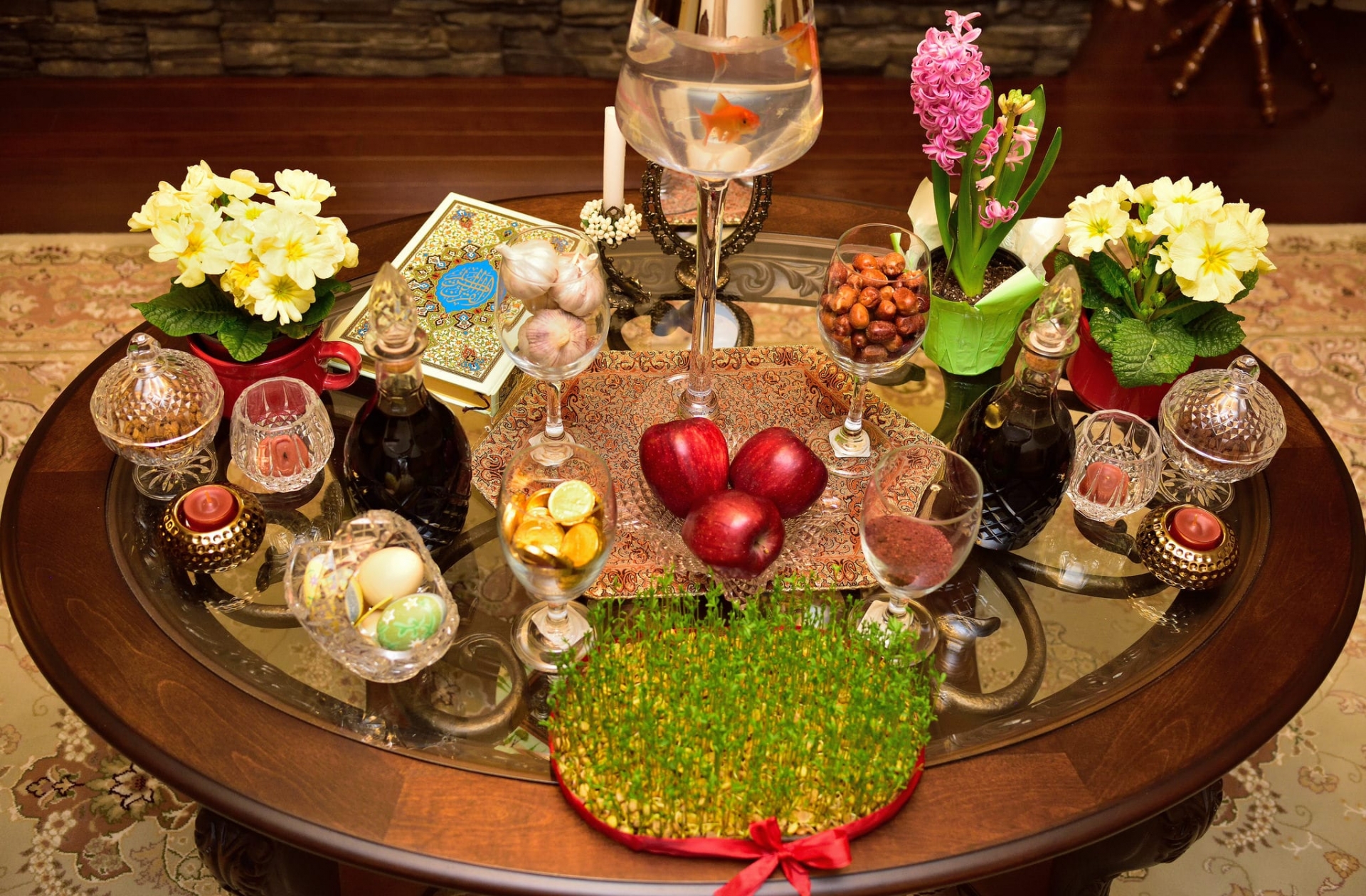 |
| Photo: SURFIRAN |
Haft-sin table for Nowruz includes flowers, goldfish, garlic, painted eggs, apples, candles and greenery.
The Haft-Sin table is an important part of Nowruz celebrations. This table is carefully set up with items, some of which will be shared with family and friends on the holiday.
A special cloth called a sofreh is first placed on the table.
Then seven traditional (food) items are arranged on it, including wheat, lentils or barley, flowers, dried fruit, garlic, apples and vinegar. Each item is a symbol of spring and renewal.
Live goldfish symbolize new life and are sometimes included on the table. Other items include eggs for fertility, coins for prosperity and a mirror for reflection.
Do they really jump over fires?
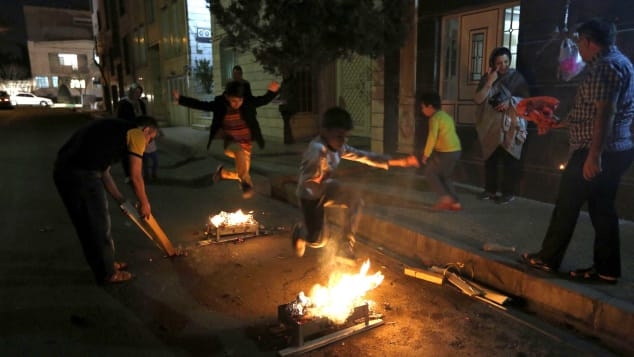 |
| Iranian families light fire outside their houses in Tehran on March 13, 2018 during Chaharshanbe Soori.. Photo: Getty Images |
Yes! The activity is one of two major traditions that mark the final few days of the old year.
Before spring rolls in, children run through the streets banging loudly on pots and knocking on doors, asking for sweets or money. It's sort of like Halloween.
On the last Wednesday of the year, Chaharshanbe Soori (or, "Red Wednesday"), crowds gather in public places and jump over bonfires, singing traditional songs and repeating the phrase, "Give me your beautiful red color and take back my sickly pallor!"
Iranian families lit a fire outside their houses in Tehran on March 13, 2018, during Chaharshanbe Soori.
Iranian families lit a fire outside their houses in Tehran on March 13, 2018, during Chaharshanbe Soori.
The fire serves as a symbol of light and good, while families wish for enlightenment and happiness for the new year, the Iran Chamber Society says.
Nowruz also traces its origins to the ancient religion of Zoroastrianism, in which fire was a central focus. Light and fire in the religion were "essential elements for sustaining life," according to the Heritage Institute.
What food is important for the holiday?
 |
| Photo: NPR |
While jumping fires and pot-banging sounds tempting, nothing compares with the dishes brought out during the Iranian New Year. The Persian cuisine, already famed for its variety of grilled meats and fluffy rice, leaves the old year behind with feasts of stews, spicy foods and colorful cookies and pastries.
Herbs are key. Fish, meat, rice, noodles and beans in various dishes are all peppered with fresh mint, tarragon, basil and other green herbs.
The main Nowruz dish is Sabzi Polo Mahi: fried fish beside rice filled with green herbs. Another, Dolmeh Barg, includes cooked meat and rice stuffed inside grape leaves. And Fesenjan, one of Iran's most famous stews, offers meat, usually chicken and sometimes duck, in pomegranate and walnut sauce.
The list goes on and on. What's most important about the food of Nowruz is that it's shared by family, friends and neighbors.
What happens after Nowruz?
Iranians picnic in the park to celebrate Sizdah Bedar, the 13th day of Nowruz.
Iranians picnic in the park to celebrate Sizdah Bedar, the 13th day of Nowruz. Atta Kenare/Getty Images
Thirteen days after Nowruz is celebrated, a festival called Sizdah Bedar (say "sees-DAH bay-dar") is held.
On this day, families spend time outside at a park or in the countryside and have a festive picnic. The day is all about being outside in nature and enjoying spring.
At the end of the day, each family throws away the greenery from their Haft-Sin table. This ritual symbolizes a new beginning for families as the New Year gets started.
| Celebrating Nowruz this year The themes of health, justice and respect for the Earth seem to be more relevant to the entire world this year than ever before. As the pandemic spread across the world, it exposed inequalities. Studies found that Black Americans were three times more likely than whites to get COVID-19, as a result of many racial inequalities. Following the death of George Floyd in May 2020, thousands of Americans took to the streets to protest racism. At the same time, many news reports noted how the Earth was healing as people stayed indoors. Global warming has led to climate change, which in turn has caused catastrophic changes in many parts of the world. While the festivities will definitely be more subdued than usual due to COVID-19, the self-reflection and inner bonding with the Earth will still be part of the celebrations of Nowruz this year. |
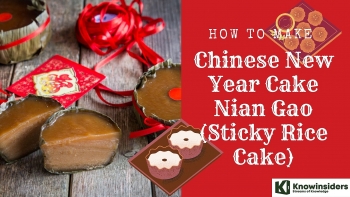 How to Make Nian Gao (Sticky Rice Cake) - Chinese New Year Cake How to Make Nian Gao (Sticky Rice Cake) - Chinese New Year Cake With New Year coming close, let's learn to make Chinese New Year Nian Gao - The traditional beloved cake that brings delicious and distinctive flavors ... |
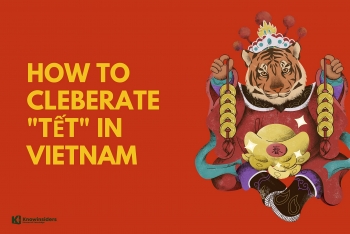 How to Celebrate a Vietnamese New Year's (Tet) How to Celebrate a Vietnamese New Year's (Tet) The lunar new year holiday, known simply as Tết, is the happiest time of year in Vietnam. How to celebrate Vietnamese New Year (Tet)! |
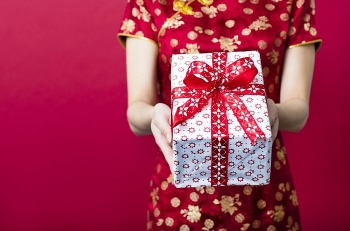 Chinese New Year Gifts Giving Etiquette Chinese New Year Gifts Giving Etiquette During Chinese New Year, people will give gifts to their loved ones to express their care and bring gifts when you are invited is always ... |
















